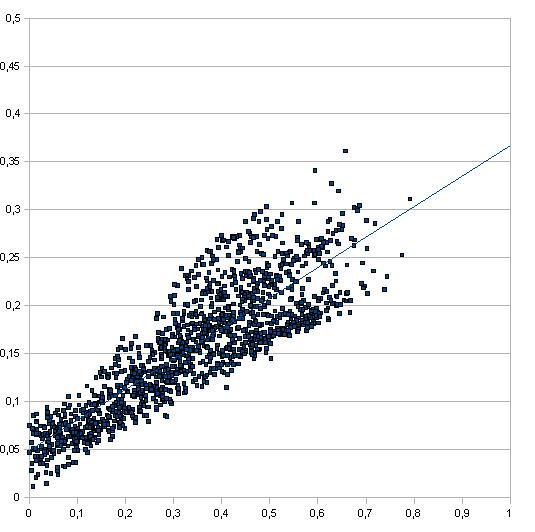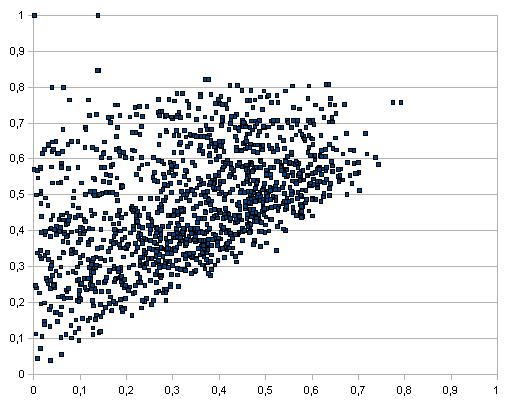Aspie hunting
April 6th, 2010Ordinary hunting is usually a group activity. Part of the tactic is to scare animals out of their hiding places so strategically placed hunters can throw spears at them (or use fire-arms in the modern variant), wound them, and ultimately, kill them from a distance. This type of hunting is erratic in nature, and usually has rather poor outcome and has to be carried out many times before it is successful. Many of today’s sport games resemble such hunting, especially team-sports.
The Aspie hunting group has caused lots of confusion among people that do Aspie-quiz. This is probably because hunting is usually associated with guns, throwing spears and killing animals at a distance. The questions in this category in Aspie-quiz give no associations at all to this kind of hunting.
So what then is Aspie hunting? The history behind the traits is pretty long. The habitat traits (like liking slowly flowing water) were introduced very early in the evolution of Aspie-quiz, but at that time was not thought to be hunting traits. The main traits, however, are more recent, and were used to evaluate Valerius Geist’s Neanderthal paradigm.
Geist’s Neanderthal paradigm was published in the 1970s and was a novel way to solve several mysteries about Neanderthal tools and why they selected the prey species they did. A central observation by Geist was that all prey species had fur. He therefore presumed that Neanderthal’s had used this property of their prey in their hunting tactics. The Mousterian tool-kit also seem to lack throwing spears, and instead contains larger tools that seems to work a lot better as stabbing spears. The rodeo-like injuries of Neanderthal are also largely unexplained by proponents that like to think that Neanderthals must have been hunting in the same manner as us, only less successfully, and with cruder weapons.
While Valerius Geists hypothesis goes a long way at explaining the archeology, it says little about the psychology and specific adaptations of Neanderthal. These aspects were researched in Aspie-quiz to try to confirm (or disprove) Geists hypothesis. There were a lot of predictions from the hypothesis that could be tested.
The following traits were predictions (listed with their predicted function) that were highly successful (correlated well with Aspie score and each others):
- Walking on toes – related to sneaking
- Enjoying spinning in circles – related to an animal trying to get rid of the hunter
- Enjoying hanging upside-down – yet another way to stay on the animal
- Having an urge to jump over things – related to jumping up on top of an animal
- Enjoying digging – related to hiding a large kill
- Mimicking animal sounds – a way of tricking an animal
- Enjoying throwing small things – another way of tricking an animal that the hunter is somewhere else
- Sniffing people or things – related to tracking
- Enjoying chasing animals or people – close encounter hunting
- Enjoying biting (people) – a paralysing tactic that Geist proposes
- Enjoying making traps – this is an obvious addition to Geist’s hypothesis
A few of the physical traits got no relevance to being Aspie, but still correlated with Aspie hunting. Typically, these traits are believed to be part of the motor problems of Aspies, and thus have an inherit bias against them:
- Being good at climbing
- Strong grip
- Strong hands
Some other traits also related to Aspie-hunting
- Being fearless in dangerous situations
- Highly variable activity level
- Naturally communicating feelings with animals
It is notable that perception issues correlate closely to Aspie hunting. The relation here seems to be obvious. Highly sensitive senses is important for passive hunting, especially hearing (sounds that animals make), tactile (vibrations that animals make) and smell (tracking an animal). Acute vision and detail perception are also related to finding signs of an animal that are not required with the usual hunting method that favors getting an whole picture of the environment. These things also extend to paranormal experience.
Additionally, many stims (Aspie-quiz defines these as Aspie communication) are related to Aspie hunting. For instance, spinning in circles, walking on toes and mimicking animal sounds could be characterized as both stims and hunting-related traits. The relation here is probably that Neanderthals adapted their nonverbal communication to their prey animals, and thus gained increased hunting success by being able to better understand their prey. This is also why Aspies today say they can both naturally interpret animals and cannot naturally interpret neurotypical humans. The communication traits are based on a difference, not an absence. There are also nonverbal communication traits that seems to be shared among Aspies, and that can be used to identify Aspies.
The habitat traits (that correlate with the pure hunting adaptations are these):
- Liking slowly flowing water
- Liking mist or fog
- Enjoying woods
From these we can presume that Neanderthals probably selected their ambush places near water. The like for mist and fog could be a hunting preference, or it could be an adaptation to living near glacials, which would produce mist / fog. We can also presume that Neanderthals hunted in forrests, not in open environments. Their tactic would be far more successful in a forrest than on the open plain, and similarily, the modern hunting tactic is more successful in a relatively open terrain.
Other types of traits can also be associated with Aspie hunting. For instance, it is not a long-shot to propose that special interests and the splinter-skills of Savants are related to passive hunting. Passive hunting requires lots of creative talents and persistence for success. Obsessions can also easily be entered into the equation. Once a hunter has found a successful way to bring down a prey, he/she is likely to keep to it, and only modify it slightly to make it more successful. The erratic methods of modern human hunting do not lend themselves to doing things in the same way, and thus such obsessions are absent in neurotypicals. Neurotypical people instead have people obsessions, as these are central for group-hunting.
In sumary, understanding Aspie/Neanderthal hunting seems to be central for understanding most parts of the autistic spectrum.


